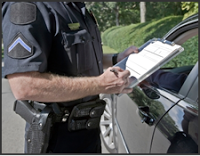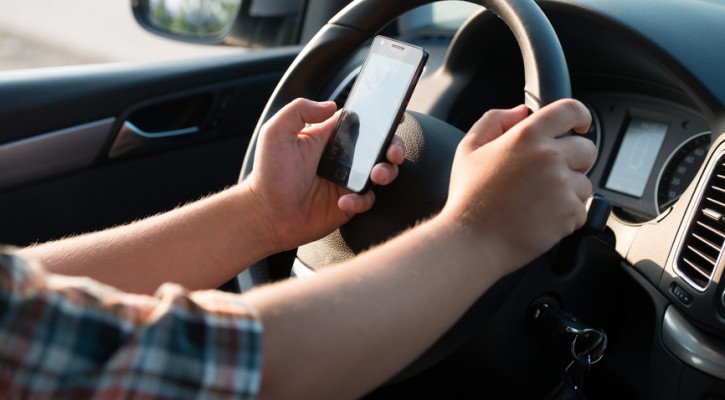
Project Note Home in Wyoming Should Keep Teens on the Straight and Narrow
June 7, 2007
The state of Wyoming has implemented a great new plan called “Project Note Home.” It seems that new teenage drivers tend to not share the fact that they receive traffic tickets with their parents. Shocking, isn’t it? In fact, parents are pretty much clueless until the next insurance bill comes along. However, with “Project Note Home,” any traffic infraction gets communicated to the parents.
Keeping parents in the loop about their teen’s driving record is a smart move for the state. Too often, teens have found out ways to pay for their tickets without their parents finding out about it. These teens are not being held accountable for their actions. What are a few bucks in fines compared to having their driving privileges suspended? Well, with this new program, copies of the traffic violation are being sent home to the parents. Teenagers will now have no way to hide their driving violations.
No longer will parents be shocked to find their teen’s auto insurance bill going up several hundred dollars. Now, they will know exactly why – their teenagers are not practicing safe driving practices. You can bet that a lot more teenagers will experience suspended driving privileges as a result of “Project Note Home.”
There is a side benefit to this new program as well. It could very well save the lives of many teenager drivers. It’s a proven fact that the biggest death toll in car accidents every year fall within the fifteen to twenty year old range. Teenagers are inexperienced. They have not come across every driving situation experience yet. With that inexperience come potential problems.
By being held accountable for every infraction while behind the wheel of a car, teenagers will soon learn to shape up their habits. Speeding is one of the biggest violations on the road along with not wearing a seat belt. Both of these infractions can kill. By alerting parents to the fact that their teenagers are not engaging in safe driving behaviors, this will open a dialogue between the parent and the teen. They will be forced to talk about the situation and perhaps, a lesson or two will be learned.
Teaching Teens to Drive: MetLife Offers Five Simple Tips
May 22, 2007
Many parents probably remember the day their teen received their learner’s permit and first asked to borrow the family car. For moms and dads, it can be scary to think of their children out on the road. If you taught them well, you can be assured they’ll make the right decisions when behind the wheel, but you can’t always count on other drivers to be responsible and safe. As parents, you may not be able to be with your children every waking hour, making sure they do the right thing, but if you have trained them well, then letting go of some control over them gets easier.
This is especially true when it comes time to teaching your teen to drive. Considering that auto-related accidents are the leading cause of death for young people aged 15 to 20 years, it is so important for parents to be a part of their teen’s driving education. Studying good driving habits from a trusted adult has proven to help save the lives of many teens during their first year of driving. Lack of education and experience both contribute to poor decision making by teens, and parents can help with both.
According to insurance company MetLife Auto & Home, there are a few simple steps you can take to help your teen while learning to drive:
– Be a good driving example. Your children won’t always do what you say, but they will do what you do. If you teach them to follow speed limit signs, wear a seatbelt, and be sober — you better be prepared to follow up your words with actions. Even at an early age, children absorb what goes on around them. Being a responsible and safe driver will help your teens learn by example.
– Get a view from the passenger’s side. It’s easy to be a “backseat driver” when you forget what it’s like to be a passenger. If you’re the one always behind the wheel, take a trip with someone in the passenger seat, so you remember what it’s like to be a passenger under normal conditions. That way, when your teen drives you around, you’ll know it’s normal for mailboxes to whiz by at the edge of the road.
– Short and patient lessons are best. When lessons are short, your teen is more likely to remember all that was covered. Also, it leaves less time for either one of you to become frustrated and impatient. You want to end your lessons on a good note, so keep it short and simple.
– Write down your progress. Some states require you to record the number of hours spent behind the wheel with your teen, so it makes sense to keep a log of the dates you train, what you covered, and how long you spent. You can also keep track of what needs improving upon, so that it can be covered again on a future date.
– Keep your eyes open and voice down. Everyone knows that teenagers get defensive when their parents get angry, and loud voices and criticisms are sure to have the same effect. When riding in the passenger seat, it’s best for parents to remain calm. At the same time, keeping an eye out for hazards or irresponsible drivers is important. Alert your teen to any dangers, and even if they are able to avoid them, teach them about the importance of defensive driving and being prepared for the unexpected.
An information guide, “Teaching Your Teens to Drive (Without Driving Each Other Crazy!),” is available from MetLife Auto & Home by calling 1-800-MET-LIFE.
Create your own customized Parent-Teen Driving Contract online based on the recommendations from the Driver Education Handbook for Parents. Our interactive tool will help you and your teen compose a practical contract of rules regarding driving expectations and car privileges that both parties can agree on.

Florida Police Officers Worry About Distraction and Safety
April 27, 2007
As the parent of a teenage driver, Police Chief Roger Boatner, of Lakeland, Florida worries when his daughter is behind the wheel. However, his worries are not with her own driving skills or with the locations she visits. He worries most about the many drivers he sees doing nearly everything but driving as they cruise down the street.
Those who spend even a few seconds changing a CD, answering the cell phone, or taking a bite of a sandwich can cause a serious accident. Other troopers agree with the seriousness of the problem of distracted driving. Larry Coggins of the Florida State Highway Patrol claims that in every crash there can be some type of driver error found.
Many studies have been done on the effects of cell phones and other distractions while driving. While exact numbers have varied, the basic results have been the same.
- Virginia Tech’s Transportation Institute found that drivers who talk on cell phones are 4 times more likely to be involved in a serious crash.
- The National Highway Traffic Administration carried out a study, which found that more than 75% of crashes and 66% of near misses occurred when drivers were engaged in conversations on cell phones.
- The University of Utah carried out an experiment that resulted in the conclusion that drivers talking on cell phone were just as impaired as an intoxicated driver.
Results such as these have caused a few states to pass laws prohibiting all drivers from talking on cell phones while behind the wheel. Even more states have implemented similar laws, but focused them only on teenage drivers. Unfortunately, Florida is yet to have created one of these laws.
The Sheriff’s Office in Polk County, Florida has decided that these messages are so important that they have placed them on their phone system as a hold message. Additionally, they remind drivers of the importance of wearing their seat belts.
The Polk Sheriff’s Office handled 50 traffic deaths within their jurisdiction. Of these, officers believe that at least 14 lives would have been saved if the victims had been wearing a seat belt. To prevent more of these accidents from claiming the lives of young people, Florida has enacted a law allowing officers to pull cars over if passengers under the age of 18 years old are seen unrestrained.

Winnebago School Board Says Driver’s Ed Is A Privilege, Not A Right
April 5, 2007
Drawing on a tactic long used by parents to influence their teenager’s actions, schools are now dangling the car keys in front of students as a motivator. The Winnebago school board in Illinois has decided to place a bit of extra responsibility on its sophomore students, letting their grades decide if they are eligible to take a school sponsored driver education program.
Following in the footsteps of other regulations within the district applying to sports and other activities, students must now maintain a 2.0 grade point average in order to participate in the school’s driver education program. Placement in these classes is highly sought after, as they cost half of what instruction at a private driver’s education course would.
This restriction adds to the ever-growing list of laws and regulations regarding teenage drivers, frustrating students a bit. However, the additional monitoring and responsibility will only lower the risks related to the youngest of drivers.
Some of the other laws, besides the new grade requirements, include:
- Cell phones may not be used while driving.
- Drivers may not have more than one unrelated passenger under the age of 20 in their vehicle within the first 6 months of being licensed.
- Teen drivers must be off the roads before 11 pm on weekdays and midnight on weekends.
All of these regulations have been put in place to reduce the accident rate among teenage drivers. Insurance Institute for Highway Safety studies show that the accident rate per mile for drivers under twenty years old is four times that of an experienced driver. The youngest of these drivers, at sixteen years old, are involved in twice the number of accidents as the eighteen and nineteen year old drivers.
The Winnebago school district has already passed this plan within their own district, however it is not finalized for next fall as of yet. Since the Illinois State Board of Education rules are more relaxed, they must apply for a waiver to tougher their own school’s restrictions. Once this waiver is approved, the plan will start in the school year immediately following.
Create your own customized Teen Driving Contract online based on the core principles of the Driver Education Handbook for Parents and Florida’s Graduated Licensing laws.

Teens Educate Teens On Safer Driving
March 14, 2007
Making sure your teenage driver is aware of the dangers of drinking and driving is always a first priority when preparing them to take to the roads. However, many parents and educators forget to stress the importance of driving without distractions. While drunk driving causes many accidents each year, just as many accidents and deaths are caused by teenage drivers who are distracted by cell phones, radios, and conversations with their passengers. All of these accidents could have been easily prevented.
State Farm has teamed up with a group of students in an Algonquin, Illinois high school to educate teenage drivers on the dangers of driving while distracted. Backed by a grant of $92,000 from State Farm Auto Insurance, this student group has started a program called “In the Blink of an Eye.” The group of students involved as come up with various strategies to help educate fellow students throughout the area about the importance of seatbelt use and the dangers of distracted driving.
Students have set up parking lot checks to remind their peers to buckle up and turn off their cell phones while driving. They have also put together presentations about safe teenage driving, including a safety education night for students currently enrolled in driver education classes. This offers both students and parents a chance to learn more about the effects of distracted driving, making the program a community wide effort. With a successful program established in their own school, they are about to take their message on the road.
Coming in April 2008, there will be a conference for schools in Illinois, Indiana, Michigan, and Wisconsin, giving other students and educators the information and ideas needed to set up a similar program in their own schools. The conference will be free to any schools within these states. State Farm and the creators of “In the Blink of an Eye” hope to spread the message about safer teen driving and reduce the number of fatalities among teenage drivers.
